11.2: Insects
- Page ID
- 12258
\( \newcommand{\vecs}[1]{\overset { \scriptstyle \rightharpoonup} {\mathbf{#1}} } \)
\( \newcommand{\vecd}[1]{\overset{-\!-\!\rightharpoonup}{\vphantom{a}\smash {#1}}} \)
\( \newcommand{\dsum}{\displaystyle\sum\limits} \)
\( \newcommand{\dint}{\displaystyle\int\limits} \)
\( \newcommand{\dlim}{\displaystyle\lim\limits} \)
\( \newcommand{\id}{\mathrm{id}}\) \( \newcommand{\Span}{\mathrm{span}}\)
( \newcommand{\kernel}{\mathrm{null}\,}\) \( \newcommand{\range}{\mathrm{range}\,}\)
\( \newcommand{\RealPart}{\mathrm{Re}}\) \( \newcommand{\ImaginaryPart}{\mathrm{Im}}\)
\( \newcommand{\Argument}{\mathrm{Arg}}\) \( \newcommand{\norm}[1]{\| #1 \|}\)
\( \newcommand{\inner}[2]{\langle #1, #2 \rangle}\)
\( \newcommand{\Span}{\mathrm{span}}\)
\( \newcommand{\id}{\mathrm{id}}\)
\( \newcommand{\Span}{\mathrm{span}}\)
\( \newcommand{\kernel}{\mathrm{null}\,}\)
\( \newcommand{\range}{\mathrm{range}\,}\)
\( \newcommand{\RealPart}{\mathrm{Re}}\)
\( \newcommand{\ImaginaryPart}{\mathrm{Im}}\)
\( \newcommand{\Argument}{\mathrm{Arg}}\)
\( \newcommand{\norm}[1]{\| #1 \|}\)
\( \newcommand{\inner}[2]{\langle #1, #2 \rangle}\)
\( \newcommand{\Span}{\mathrm{span}}\) \( \newcommand{\AA}{\unicode[.8,0]{x212B}}\)
\( \newcommand{\vectorA}[1]{\vec{#1}} % arrow\)
\( \newcommand{\vectorAt}[1]{\vec{\text{#1}}} % arrow\)
\( \newcommand{\vectorB}[1]{\overset { \scriptstyle \rightharpoonup} {\mathbf{#1}} } \)
\( \newcommand{\vectorC}[1]{\textbf{#1}} \)
\( \newcommand{\vectorD}[1]{\overrightarrow{#1}} \)
\( \newcommand{\vectorDt}[1]{\overrightarrow{\text{#1}}} \)
\( \newcommand{\vectE}[1]{\overset{-\!-\!\rightharpoonup}{\vphantom{a}\smash{\mathbf {#1}}}} \)
\( \newcommand{\vecs}[1]{\overset { \scriptstyle \rightharpoonup} {\mathbf{#1}} } \)
\( \newcommand{\vecd}[1]{\overset{-\!-\!\rightharpoonup}{\vphantom{a}\smash {#1}}} \)
\(\newcommand{\avec}{\mathbf a}\) \(\newcommand{\bvec}{\mathbf b}\) \(\newcommand{\cvec}{\mathbf c}\) \(\newcommand{\dvec}{\mathbf d}\) \(\newcommand{\dtil}{\widetilde{\mathbf d}}\) \(\newcommand{\evec}{\mathbf e}\) \(\newcommand{\fvec}{\mathbf f}\) \(\newcommand{\nvec}{\mathbf n}\) \(\newcommand{\pvec}{\mathbf p}\) \(\newcommand{\qvec}{\mathbf q}\) \(\newcommand{\svec}{\mathbf s}\) \(\newcommand{\tvec}{\mathbf t}\) \(\newcommand{\uvec}{\mathbf u}\) \(\newcommand{\vvec}{\mathbf v}\) \(\newcommand{\wvec}{\mathbf w}\) \(\newcommand{\xvec}{\mathbf x}\) \(\newcommand{\yvec}{\mathbf y}\) \(\newcommand{\zvec}{\mathbf z}\) \(\newcommand{\rvec}{\mathbf r}\) \(\newcommand{\mvec}{\mathbf m}\) \(\newcommand{\zerovec}{\mathbf 0}\) \(\newcommand{\onevec}{\mathbf 1}\) \(\newcommand{\real}{\mathbb R}\) \(\newcommand{\twovec}[2]{\left[\begin{array}{r}#1 \\ #2 \end{array}\right]}\) \(\newcommand{\ctwovec}[2]{\left[\begin{array}{c}#1 \\ #2 \end{array}\right]}\) \(\newcommand{\threevec}[3]{\left[\begin{array}{r}#1 \\ #2 \\ #3 \end{array}\right]}\) \(\newcommand{\cthreevec}[3]{\left[\begin{array}{c}#1 \\ #2 \\ #3 \end{array}\right]}\) \(\newcommand{\fourvec}[4]{\left[\begin{array}{r}#1 \\ #2 \\ #3 \\ #4 \end{array}\right]}\) \(\newcommand{\cfourvec}[4]{\left[\begin{array}{c}#1 \\ #2 \\ #3 \\ #4 \end{array}\right]}\) \(\newcommand{\fivevec}[5]{\left[\begin{array}{r}#1 \\ #2 \\ #3 \\ #4 \\ #5 \\ \end{array}\right]}\) \(\newcommand{\cfivevec}[5]{\left[\begin{array}{c}#1 \\ #2 \\ #3 \\ #4 \\ #5 \\ \end{array}\right]}\) \(\newcommand{\mattwo}[4]{\left[\begin{array}{rr}#1 \amp #2 \\ #3 \amp #4 \\ \end{array}\right]}\) \(\newcommand{\laspan}[1]{\text{Span}\{#1\}}\) \(\newcommand{\bcal}{\cal B}\) \(\newcommand{\ccal}{\cal C}\) \(\newcommand{\scal}{\cal S}\) \(\newcommand{\wcal}{\cal W}\) \(\newcommand{\ecal}{\cal E}\) \(\newcommand{\coords}[2]{\left\{#1\right\}_{#2}}\) \(\newcommand{\gray}[1]{\color{gray}{#1}}\) \(\newcommand{\lgray}[1]{\color{lightgray}{#1}}\) \(\newcommand{\rank}{\operatorname{rank}}\) \(\newcommand{\row}{\text{Row}}\) \(\newcommand{\col}{\text{Col}}\) \(\renewcommand{\row}{\text{Row}}\) \(\newcommand{\nul}{\text{Nul}}\) \(\newcommand{\var}{\text{Var}}\) \(\newcommand{\corr}{\text{corr}}\) \(\newcommand{\len}[1]{\left|#1\right|}\) \(\newcommand{\bbar}{\overline{\bvec}}\) \(\newcommand{\bhat}{\widehat{\bvec}}\) \(\newcommand{\bperp}{\bvec^\perp}\) \(\newcommand{\xhat}{\widehat{\xvec}}\) \(\newcommand{\vhat}{\widehat{\vvec}}\) \(\newcommand{\uhat}{\widehat{\uvec}}\) \(\newcommand{\what}{\widehat{\wvec}}\) \(\newcommand{\Sighat}{\widehat{\Sigma}}\) \(\newcommand{\lt}{<}\) \(\newcommand{\gt}{>}\) \(\newcommand{\amp}{&}\) \(\definecolor{fillinmathshade}{gray}{0.9}\)
What dominates life on Earth?
Well, by numbers, it's not humans. This may look like a scary creature from your worst nightmare, but it wouldn’t hurt a fly. In fact, it is a fly! The picture shows the charming portrait of a horsefly, up close and personal. Those big, striped, colorful orbs are its eyes. Did you ever look through a kaleidoscope? If so, then you have an idea of what the world looks like to a horsefly.
What other organs do insects like this horsefly have? Besides sensing their environment, what other functions do their organs serve?
Insects
Most members of the subphylum Hexapoda are insects (class Insecta). In fact, more than half of all known organisms are insects. There may be more than 10 million insect species in the world, most of them yet to be identified. It’s clear that insects, and not humans, dominate life on Earth.
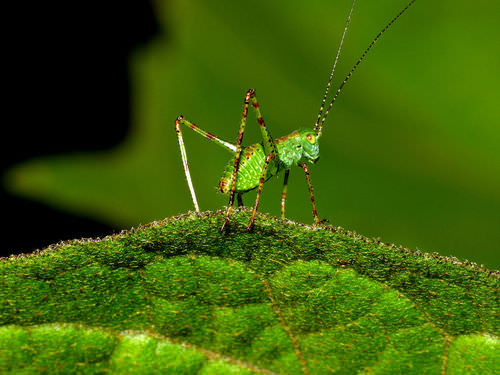 Hexapoda. A cricket on green leaf. Can you find the six legs attached to the thorax?
Hexapoda. A cricket on green leaf. Can you find the six legs attached to the thorax?Structure and Function of Insects
Insects range in length from less than a millimeter to about the length of your arm. They can be found in most habitats, but they are mainly terrestrial. Many can fly, so they are also aerial. Like other arthropods, insects have a head, thorax, and abdomen. They have a wide variety of appendages, including six legs attached to the thorax.
Insects have a pair of antennae for “smelling” and “tasting” chemicals. Some insects can also use their antennae to detect sound. Other sensory organs on the head include several simple eyes and a pair of compound eyes. The compound eyes let insects see images. Butterflies and bees can even see in color. For feeding, the head contains one pair of mandibles and two pairs of maxillae. Insects consume a wide range of foods, and their mouthparts have become specialized. Several variations are shown in Figure below.
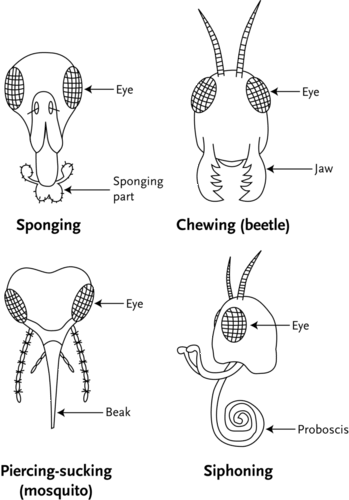 Mouthpart Specialization in Insects. The mouthparts of insects are adapted for different food sources. How do you think the different mouthparts evolved?
Mouthpart Specialization in Insects. The mouthparts of insects are adapted for different food sources. How do you think the different mouthparts evolved?An insect’s abdomen contains most of the internal organs. Like other arthropods, insects have a complete digestive system. They also have an open circulatory system and central nervous system. Like other terrestrial arthropods, they have trachea for breathing air and Malpighian tubules for excretion.
Insect Flight
The main reason that insects have been so successful is their ability to fly. Insects are the only invertebrates that can fly and were the first animals to evolve flight. Flight has important advantages. It’s a guaranteed means of escape from nonflying predators. It also aids in the search for food and mates.
Insects generally have two pairs of wings for flight. Wings are part of the exoskeleton and attached to the thorax. Insect wings show a lot of variation. As you can see in Figure below, butterfly wings are paper-thin, whereas beetle wings are like armor. Not all insect wings work the same way, either. They differ in how the muscles are attached and whether the two pairs of wings work independently or together. Besides flight, wings serve other functions. They may protect the body (beetles), communicate visually with other insects (butterflies), or produce sounds to attract mates (katydids).
 Form and Function in Insect Wings. Beetles, butterflies, and katydids all have two pairs of wings that they use for flight. However, the wings are very different because they have other functions as well.
Form and Function in Insect Wings. Beetles, butterflies, and katydids all have two pairs of wings that they use for flight. However, the wings are very different because they have other functions as well.Insect Reproduction
Nearly all insects reproduce sexually. Some can also reproduce asexually. An example of an insect life cycle is shown in Figure below.
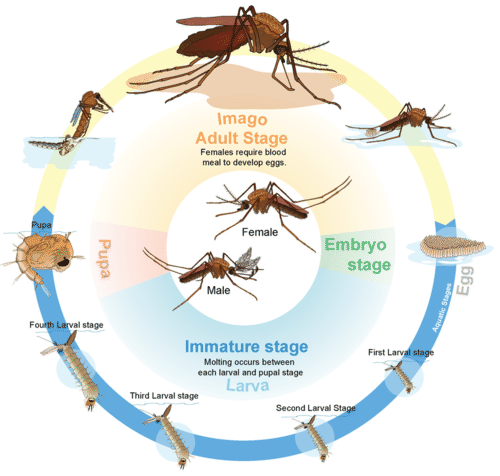 Insect Life Cycle. This diagram represents the life cycle of a mosquito. Most insects have a similar life cycle.
Insect Life Cycle. This diagram represents the life cycle of a mosquito. Most insects have a similar life cycle.When an insect egg hatches, a larva emerges. The larva eats and grows and then enters the pupa stage. The pupa is immobile and may be encased in a cocoon. During the pupa stage, the insect goes through metamorphosis. Tissues and appendages of the larva break down and reorganize into the adult form. How did such an incredible transformation evolve? Metamorphosis is actually very advantageous. It allows functions to be divided between life stages. Each stage can evolve adaptations to suit it for its specific functions without affecting the adaptations of the other stage.
Insect Behavior
Insects are capable of a surprising range of behaviors. Most of their behaviors, such as flying and mating, are instinctive. These are behaviors that don’t need to be learned. They are largely controlled by genes. However, some insect behaviors are learned. For example, ants and bees can learn where food is located and keep going back for more.
Many species of insects have evolved complex social behaviors. They live together in large, organized colonies (see Figure below). This is true of ants, termites, bees, and wasps. Colonies may include millions of individual insects. Colony members divide up the labor of the colony. Different insects are specialized for different jobs. Some reproduce, while others care for the young. Still others get food or defend the nest.
 Termite Nest. This cathedral-like structure is the nest of a huge colony of termites in Australia. In fact, it is the world’s largest known termite nest. It towers 7.5 meters (25 feet) above the ground and houses millions of termites.
Termite Nest. This cathedral-like structure is the nest of a huge colony of termites in Australia. In fact, it is the world’s largest known termite nest. It towers 7.5 meters (25 feet) above the ground and houses millions of termites.Living in a large colony requires good communication. Ants communicate with chemicals called pheromones. For example, an ant deposits pheromones on the ground as it returns to the nest from a food source. It is marking the path so other ants can find the food. Honeybees communicate by doing a “waggle dance.”
KQED: Ants: The Invisible Majority
Most of us think ants are just pests. But not Brian Fisher. Known as “The Ant Guy,” he's on a mission to show the world just how important and amazing these little creatures are. In the process, he hopes to catalog all of the world's 30,000 ant species before they become casualties of habitat loss.
KQED: Ladybugs: A Population of Millions
Ladybugs, also known as ladybird beetles, have a life cycle of four to six weeks. In one year as many as six generations of ladybird beetles may hatch. In the spring, each adult female lays up to 300 eggs in small clusters on plants where aphids are present. After a week the wingless larvae hatch. Both the ladybird beetle larvae and adults are active predators, eating only aphids, scales, mites and other plant-eating insects. The ladybugs live on the vegetation where their prey is found, which includes roses, oleander, milkweed and broccoli. Adult ladybugs don’t taste very good. A bird careless enough to try to eat one will not swallow it.
By late May to early June, when the larvae have depleted the food supply, the adults migrate to the mountains. There, they eat mainly pollen. The ladybugs gain fat from eating the pollen and this tides them over during their nine-month hibernation. Thousands of adults hibernate overwinter in tight clusters, called aggregates, under fallen leaves and ground litter near streams. In the clear, warmer days of early spring, the ladybugs break up the aggregates and begin several days of mating.
Insects and Humans
Most humans interact with insects every day. Many of these interactions are harmless and often go unnoticed. However, insects cause humans a lot of harm. They spread human diseases. For example, the deadly bubonic plague of the middle ages was spread by fleas. Today, millions of people die each year from malaria, which is spread by mosquitoes. Insects also eat our crops. Sometimes they travel in huge swarms that completely strip the land of all plant material (see Figure below). On the other hand, we depend on insects for the very food we eat. Without insects to pollinate them, flowering plants—including many food crops—could not reproduce.
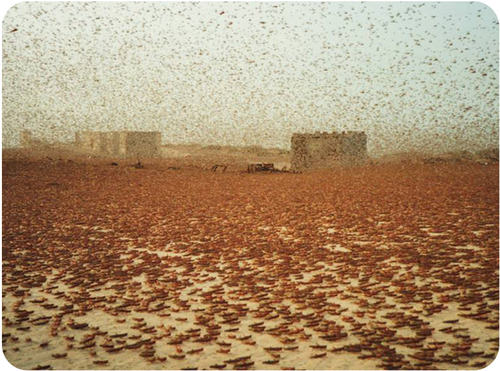 Locust Swarm. A swarm of locusts in the African country of Mauritania darkens the mid-day sky. The hungry insects will eat virtually all the plants in their path.
Locust Swarm. A swarm of locusts in the African country of Mauritania darkens the mid-day sky. The hungry insects will eat virtually all the plants in their path.KQED: Better Bees: Super Bee and Wild Bee
Honeybees are one of the most well-known insects on the planet. Bees are naturalized on every continent except Antarctica. Honeybees have a highly developed social structure and depend on their community, or colony, for survival, with a colony containing up to 20,000 bees. When bees search plants for nectar, pollen sticks to the fuzzy hairs that cover their hind legs. At the next flower, some of the pollen rubs off and fertilizes that flower. In this way, bees help improve fruit production. Bees pollinate an estimated 130 different varieties of fruit, flowers, nuts and vegetables in the United States alone. Farmers obviously depend on bees to pollinate crops, such as fruit and nuts, but in recent years thousands of bee colonies have disappeared. This could be a devastating issue for farmers. Can anything be done? Meet two Northern California researchers looking for ways to make sure we always have bees to pollinate crops.
Science Friday: The Road Best Traveled: A Tale of Ants, Slime Mold and the New Jersey Turnpike
For most people, getting stuck in a traffic jam on the New Jersey Turnpike is a grueling lesson in futility. However, in this video by Science Friday, Simon Garnier examines our collective behavior and how relatively simple organisms organize themselves so dynamically.
Summary
- Insects are arthropods in the class Hexapoda. They are the most numerous organisms in the world.
- Most insects are terrestrial, and many are aerial.
- Insects have six legs and a pair of antennae for sensing chemicals. They also have several eyes and specialized mouthparts for feeding.
- Insects are the only invertebrates than can fly. Flight is the main reason for their success.
- Insects may live in large colonies and have complex social behaviors.
- Insects spread disease and destroy crops. However, they are essential for pollinating flowering plants.
Review
- List two traits that characterize insects.
- State two important advantages of flight in insects.
- Give examples of insect behavior.
- Present facts and a logical argument to support the following statement: “Insects dominate life on Earth.”
- Explain why distinctive life stages and metamorphosis are adaptive.
- Diagram an insect life cycle.
| Image | Reference | Attributions |
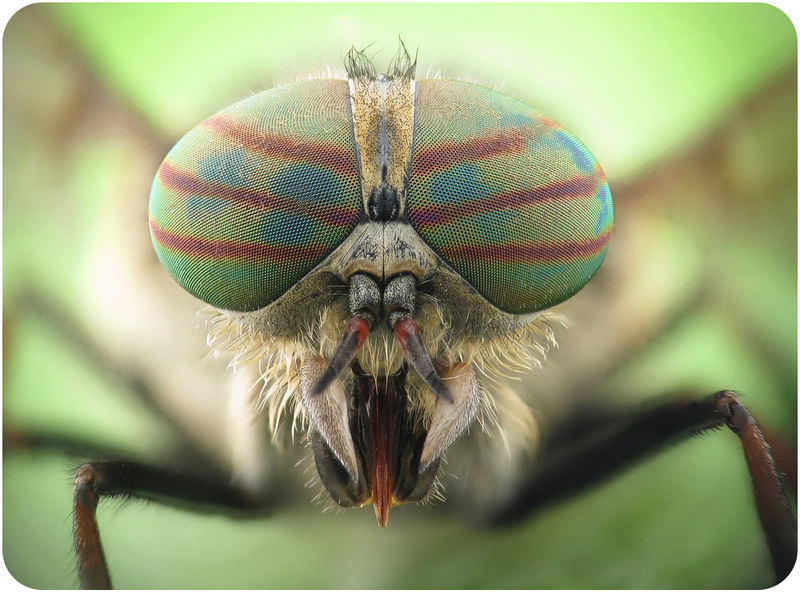 |
[Figure 1] | Credit: Courtesy of Food and Agriculture Organization of the United Nations Source: http://www.nasa.gov/topics/earth/features/ndvi_locusts.html License: Public Domain |
 |
[Figure 2] | Credit: Hugo A. Quintero G. Source: http://www.flickr.com/photos/haquintero/8182319027/ License: CC BY 2.0 |
 |
[Figure 3] | Credit: Christopher Auyeung Source: CK-12 Foundation License: CC BY-NC 3.0 |
 |
[Figure 4] | Credit: Beetle: Richard; Butterfly: Diganta Talukdar; Katydid: John Tann Source: Beetle: www.flickr.com/photos/wildpics/2450391512/ ; Butterfly: http://www.flickr.com/photos/nagaon/4394582833/ ; Katydid: http://www.flickr.com/photos/31031835@N08/7208766480/ License: CC BY 2.0 |
 |
[Figure 5] | Credit: Mariana Ruiz Villarreal (LadyofHats) for CK-12 Foundation Source: CK-12 Foundation License: CC BY-NC 3.0 |
 |
[Figure 6] | Credit: Hadi Zaher Source: http://www.flickr.com/photos/hazara/9028960551/ License: CC BY 2.0 |
 |
[Figure 7] | Credit: Courtesy of Food and Agriculture Organization of the United Nations Source: http://www.nasa.gov/topics/earth/features/ndvi_locusts.html License: Public Domain |

